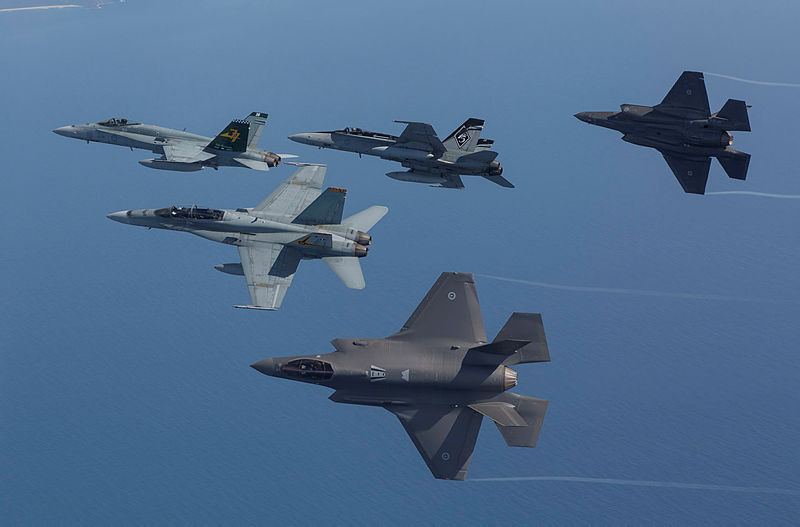
In past conflicts, many hours, days or weeks were spent gathering and analysing intelligence before an attack was launched on an enemy. Advances in science and technology have brought that time down to minutes, and sometimes even seconds, making it nearly impossible for the human brain to process the incoming avalanche of data in the time that will be available to air crews in future wars.
Royal Australian Air Force chief Leo Davies says the RAAF is training its personnel to more effectively harness the speed and accuracy with which artificial intelligence can process information to give them the edge in intense conflicts.
Air Marshal Davies says this phenomenon of ‘augmented intelligence’ will shift the RAAF from being a force that uses humans to operate machines and to cooperate with other humans, to one in which humans and machines operate together.
The goal is to out-think an enemy and to harness machine processing and sensors which see further, faster and more clearly—and to do that very fast.
The RAAF chief says the force’s advantages are its quality people and sophisticated equipment. ‘We will leverage these strengths to cognitively overwhelm our competitors by imposing human-inspired dilemmas at machine tempo across multiple domains.’
The RAAF believes that humans alone cannot cope with the deluge of data likely in modern combat, or respond to events happening at speeds and in domains beyond human comprehension.
However, its planners say machines are as yet unable to define intent and purpose or to imagine the alternative futures needed to develop effective strategies, and they can’t be held legally and morally accountable. Combinations are necessary to cope with the complexity and speed of future competition and maximise the air force’s ability to create, exploit and adapt to asymmetries.
The goal is to combine the strengths of humans and machines to create a human edge in the information age, in an ethical, moral and legal manner.
Davies says it’s vital that in introducing the F-35 joint strike fighter and other fifth-generation capabilities such as the P8 Poseidon maritime patrol aircraft, the RAAF doesn’t make the mistakes of the past. A previous RAAF chief suggested to him that when the F/18 Hornets were introduced the air force wasted years flying them as it had operated its previous fleet of Mirage fighters.
The Mirage was a high-speed, high-altitude interceptor with a modest radar and a reliance on ground control, with a missile suite that was only just adequate. Tactics were developed around that technology. The Hornet radar could see much more and its electronic warfare suite could see the radars of other aircraft. ‘It had a very capable missile system, and would fly for longer, and be performance positive at medium and high altitude’, Davies says.
‘We only used about 30% of its capability in the first four years. We were chained to our old tactics and procedures.’
The RAAF needs to understand everything that a P-8 can deliver, in surface picture, intelligence, surveillance, reconnaissance and electromagnetic spectrum and analysis, Davies says. ‘How would we get the important bits of that P-8 mission happening at 9 am to the F-35 mission that’s going to happen at 10 am in a different part of the world?
‘What bits are important, how do we send it, how do we use it? And when you ask those questions, we start to understand how each aircraft type we have has such a significant overlap with the rest of the fleet, and the army and the navy.
‘The F-35 now spends much of its mission helping other assets stay safe, be mission effective, and make decisions on their own with just a little packet of data, rather than themselves taking on every part of the fight’, the RAAF chief says. ‘We certainly find the F-35 able to orchestrate the battlespace because of superior sensor awareness.’
The F-35 has forced the RAAF to rethink the way it plans to fight, says Davies. ‘We train differently, we integrate differently. We need to receive information to make better decisions faster than the enemy can and be successful in battle if we need to be.’
Davies says that when Super Hornets operated with the army on exercises, the troops were surprised by how much the aircraft could ‘see’ on the other side of the hill and their ability to immediately pass on synthetic-aperture radar imagery to give the soldiers a current picture. With that came the aircraft’s ability to use its infrared scanners to detect enemy positions and movements at night with an assessment of what the target was.
The troops could then make decisions faster and manoeuvre with less risk.
That shows a need to spread the word through the whole of the ADF, Davies says. ‘Our maritime force needs to know what the future frigate, the new submarine, and the air warfare destroyer and the LHDs will do. We need to educate the navy on what the Triton will do, we need to integrate the Seahawk Romeo with the P-8—where can we share, and where can we improve each other’s situational awareness. This is a defence force that we hope never needs to be sent to battle, which means for me that we need to build a deterrence value.
‘What I think is very real, but not spoken about as much as it perhaps should be, is a situation where any potential adversary will look at Australia and decide, “That is going to be a tough fight. That is not worth fighting. I don't want to go there.”’
‘That’, says Davies, ‘is as valuable as winning the missile fight, should you end up in a bad place.’
 Print This Post
Print This Post